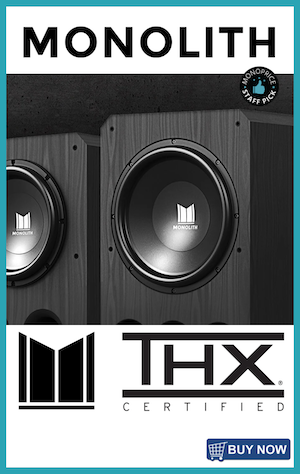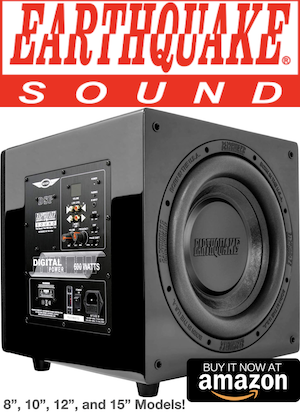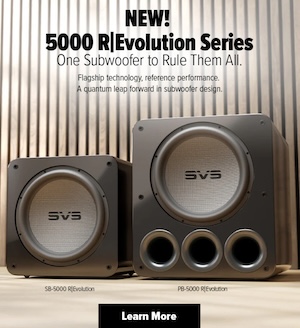Todd Anderson
Editor / Senior Partner
More
- Preamp, Processor or Receiver
- StormAudio ISP.24 MK2
- Main Amp
- Emotiva XPA-5
- Additional Amp
- Emotiva XPA Gen3 2.8 multichannel amp
- Other Amp
- Denon X8500H
- DAC
- THX ONYX
- Computer Audio
- AudioEngine A2+
- Universal / Blu-ray / CD Player
- Kaleidescape TERRA
OPPO UDP-203
Panasonic UB9000
- Streaming Equipment
- iFi Audio Zen Blue
- Streaming Subscriptions
- Spotify
- Front Speakers
- GoldenEar Technology Triton One.R
- Center Channel Speaker
- GoldenEar Technology SuperCenter Reference
- Surround Speakers
- GoldenEar Invisa MPX
- Surround Back Speakers
- GoldenEar Invisa MPX
- Front Height Speakers
- SVS Prime Elevation x4 (Top Front, Top Mid-Front)
- Rear Height Speakers
- SVS Prime Elevation x4 (Top Middle, Top Rear)
- Subwoofers
- Quad Array SVS SB16s
- Other Speakers
- Behringer 1124p; Aura Bass Shaker Pros; SuperSub X
- Screen
- Seymour Screen Excellence, Enlightor NEO AT Screen
- Video Display Device
- JVC NZ8
- Other Equipment
- Sony 65-inch A95L OLED
Sony 65-inch X900F
ZeroSurge 8R15W x 2
ZeroSurge 2R15W x 2
I suggested that @Mike Schramm consider adding bass shakers to his room.
Here's an old post from another forum, where I describe how integrated the following parts into a couch system, resulting in some great tactile bass:
Pricing has changed slightly (the shakers are $54, and low pass filters are $28), but here's the general gist of what I implemented:
I thought this would be a good opportunity to run through a few thoughts on installing a DIY shaker system and whether or not it’s worth the effort and extra coin.
Cutting to the chase, I’ve absolutely enjoyed the added jolt that bass shakers bring to the party. Truth be told, my dual subwoofer arrangement delivers more than enough power and oomph to send thumps, thuds, and ridiculous vibrations straight through my theater room’s seating. The shakers simply enhance the tactile attributes of the lower-end while adding quite a bit of directness. This is especially true when watching movies at lower sound volumes; you can independently increase the bass shaker’s volume to keep the appearance of deep bass punch.
There are lots of shaker options on the market, including kit systems like “ButtKicker” and “Earthquake.” I believe “Clarks” is another brand. Many of the kit systems come with dedicated amplifier units, feature transducers that are mighty powerful, and have a price tag that can be hefty for a side feature. In my case, I had a spare Pioneer Elite amplifier on-hand and decided to use it as a dedicated power source for shakers. I then went to our old friends at Parts Express and purchased six AuraSound AST-2B-4 Pro Bass Shaker units for a price (something in the neighborhood of $40 per unit) that literally blew away the competition.
AuroSound’s shakers are marketed for all kinds of applications, including video game cabs, and car and theater seating. They’re rated at 4 ohms / 50 Watts per unit. While they might be weaker than other options, they’re cheap enough to buy in multiples to increase impactful power.
There are all different ways to power bass shakers. Some folks use plate amps, others (like me) use old amps, while others buy new – cheap – dedicate amps.
My theater seating consists of a LuvSac modular couch (which, non-sequitur, is one nifty piece of furniture). I opted to buy two bass shakers per seating section of the couch. Now, due to the size of the LoveSac seating surfaces, this doesn’t exactly equate to one chair, but if I were outfitting singular seating or a couch with smaller seating surfaces, I’d still dedicate two per seat. After some trial-by-error, I ended up installing wood inside of the couch’s frame, which allowed me to mount the shakers facing “up” into the seating. This is a key point of emphasis. If you want the most tactile response, then mount the shakers facing in the up position. The short story is that I originally mounted the shakers on side facing portions of the furniture and the result was rather “meh.” So take the time to do it right and get the Pro Bass Shakers facing up. Next, I wired the speakers in pairs from three terminals of the Elite amp – each wired in series. If you’re not familiar with series versus parallel wiring, Google it and you’ll find plenty of information to guide the process.
The Elite shaker amp is fed subwoofer information via the sub-out from my primary amplifier source. If your amp or AVR doesn’t have two sub-outs, buy an RCA splitter, split the sub-out line, and run an RCA input into your shaker amp. You likely will have your primary pre-amp/AVR’s low frequency crossover set a 80HZ. This means that your bass shakers will play everything from 80HZ on down. You don’t want that because it introduces some shaker rumble with voices and other information that comes off as odd through the shaker system. To combat this, you’ll need to buy a 50Hz low pass filter (also available at Parts Express). The filter is plug-and-play in the RCA chain and simply acts as another low frequency cut-off point (now your shakers will only hammer away at information from 50Hz and down).
I’ve found that my Elite amp and six-unit AuroSound shaker combination performs best when the volume on the Elite amp is at or slightly below zero. Sometimes, during extraordinarily heavy bass scenes, the amp will trip. That’s unusual, however. You’ll eventually get to know how your system behaves with different levels of bass aggressiveness and it will be easy to make volume adjustments.
I hope this helps to open the door to the world of shakers for the uninitiated. I’m sure the kit systems are equally easy to implement. Definitely give this added realm of tactile rumble a consideration, especially if you’re a fan of action movies with impact!
Here's an old post from another forum, where I describe how integrated the following parts into a couch system, resulting in some great tactile bass:
Dayton Audio BST-1 High Power Pro Tactile Bass Shaker 50 Watts, link: https://fave.co/3WcYmxN
Harrison Labs FMOD Inline Crossover Pair 50 Hz Low Pass RCA, link: https://fave.co/4aoCtli
RCA splitter, 1 male 2 female: link: https://amzn.to/3C9x8Bs
Pricing has changed slightly (the shakers are $54, and low pass filters are $28), but here's the general gist of what I implemented:
I thought this would be a good opportunity to run through a few thoughts on installing a DIY shaker system and whether or not it’s worth the effort and extra coin.
Cutting to the chase, I’ve absolutely enjoyed the added jolt that bass shakers bring to the party. Truth be told, my dual subwoofer arrangement delivers more than enough power and oomph to send thumps, thuds, and ridiculous vibrations straight through my theater room’s seating. The shakers simply enhance the tactile attributes of the lower-end while adding quite a bit of directness. This is especially true when watching movies at lower sound volumes; you can independently increase the bass shaker’s volume to keep the appearance of deep bass punch.
There are lots of shaker options on the market, including kit systems like “ButtKicker” and “Earthquake.” I believe “Clarks” is another brand. Many of the kit systems come with dedicated amplifier units, feature transducers that are mighty powerful, and have a price tag that can be hefty for a side feature. In my case, I had a spare Pioneer Elite amplifier on-hand and decided to use it as a dedicated power source for shakers. I then went to our old friends at Parts Express and purchased six AuraSound AST-2B-4 Pro Bass Shaker units for a price (something in the neighborhood of $40 per unit) that literally blew away the competition.
AuroSound’s shakers are marketed for all kinds of applications, including video game cabs, and car and theater seating. They’re rated at 4 ohms / 50 Watts per unit. While they might be weaker than other options, they’re cheap enough to buy in multiples to increase impactful power.
There are all different ways to power bass shakers. Some folks use plate amps, others (like me) use old amps, while others buy new – cheap – dedicate amps.
My theater seating consists of a LuvSac modular couch (which, non-sequitur, is one nifty piece of furniture). I opted to buy two bass shakers per seating section of the couch. Now, due to the size of the LoveSac seating surfaces, this doesn’t exactly equate to one chair, but if I were outfitting singular seating or a couch with smaller seating surfaces, I’d still dedicate two per seat. After some trial-by-error, I ended up installing wood inside of the couch’s frame, which allowed me to mount the shakers facing “up” into the seating. This is a key point of emphasis. If you want the most tactile response, then mount the shakers facing in the up position. The short story is that I originally mounted the shakers on side facing portions of the furniture and the result was rather “meh.” So take the time to do it right and get the Pro Bass Shakers facing up. Next, I wired the speakers in pairs from three terminals of the Elite amp – each wired in series. If you’re not familiar with series versus parallel wiring, Google it and you’ll find plenty of information to guide the process.
The Elite shaker amp is fed subwoofer information via the sub-out from my primary amplifier source. If your amp or AVR doesn’t have two sub-outs, buy an RCA splitter, split the sub-out line, and run an RCA input into your shaker amp. You likely will have your primary pre-amp/AVR’s low frequency crossover set a 80HZ. This means that your bass shakers will play everything from 80HZ on down. You don’t want that because it introduces some shaker rumble with voices and other information that comes off as odd through the shaker system. To combat this, you’ll need to buy a 50Hz low pass filter (also available at Parts Express). The filter is plug-and-play in the RCA chain and simply acts as another low frequency cut-off point (now your shakers will only hammer away at information from 50Hz and down).
I’ve found that my Elite amp and six-unit AuroSound shaker combination performs best when the volume on the Elite amp is at or slightly below zero. Sometimes, during extraordinarily heavy bass scenes, the amp will trip. That’s unusual, however. You’ll eventually get to know how your system behaves with different levels of bass aggressiveness and it will be easy to make volume adjustments.
I hope this helps to open the door to the world of shakers for the uninitiated. I’m sure the kit systems are equally easy to implement. Definitely give this added realm of tactile rumble a consideration, especially if you’re a fan of action movies with impact!
Last edited:














